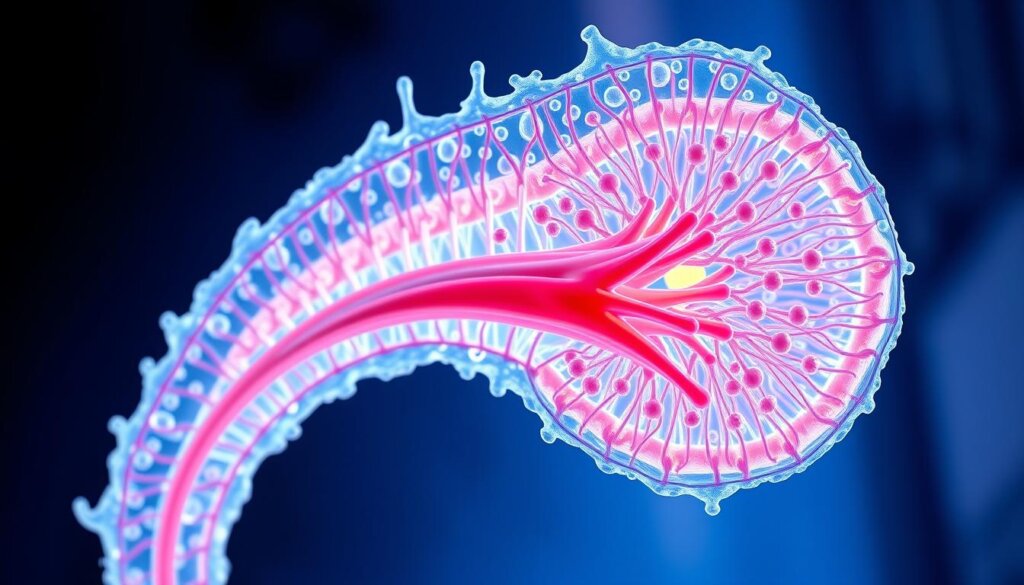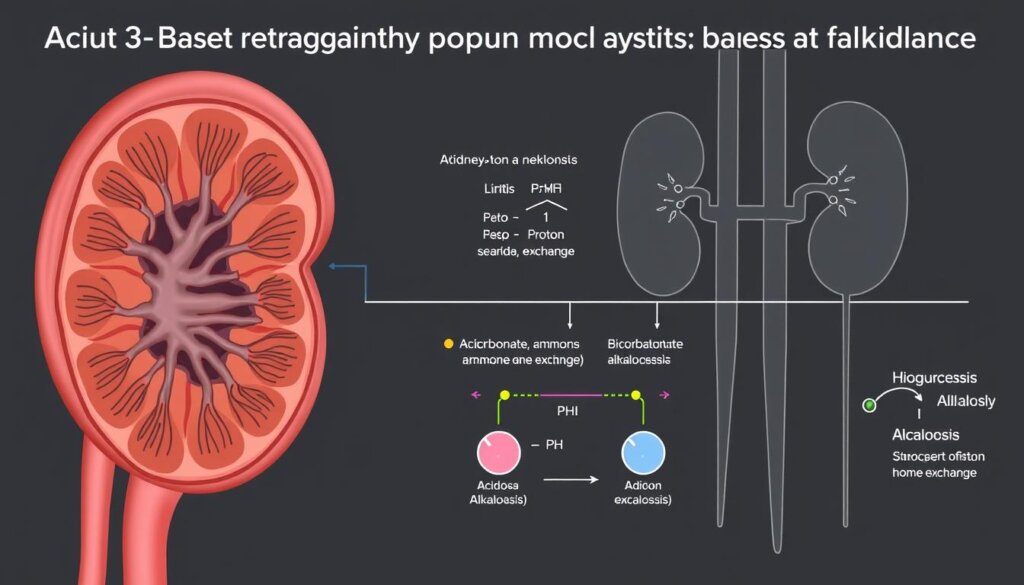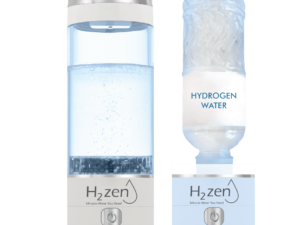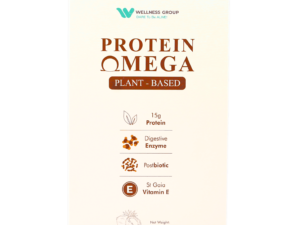Surprising fact: this organ can raise urine hydrogen ion concentration up to about 2,500 times that of plasma, or lower it to one-quarter.
This short guide shows how that power protects blood pH. It explains how filtered bicarbonate is largely reclaimed in proximal segments so plasma stays near 25 mmol/L, and why bicarbonate appears in urine above ~27 mmol/L.
Readers learn practical numbers: normal urine pH spans 4–8 and daily volume averages about 1.5 liters. Net acid secretion is roughly 50–100 mmol per day but rises with increased acid production.
Wellness Group makes this relevant for life in Malaysia and offers friendly advice. For personalised help, contact Wellness Group on WhatsApp at +60123822655. Business hours: Monday–Friday 9:30 am–6:30 pm; Saturday–Sunday 10 am–5 pm.
Key Takeaways
- The organ keeps blood pH near 7.40 by moving acid into urine and reclaiming base.
- Most bicarbonate is reabsorbed in proximal segments; final acid excretion happens distally.
- Typical urine pH is 4–8 and daily volume is about 1.5 L, so labs tie to daily habits.
- Net acid secretion is about 50–100 mmol/day and varies with diet, illness, and exercise.
- Understanding this system links lab results, clinical issues, and everyday care.
Understanding acid-base balance: why hydrogen ions matter for kidney health
Clear steps show how body systems team up to keep blood pH close to 7.40 despite constant acid loads.
User intent and what this ultimate guide covers
This guide helps readers grasp acid-base balance in simple terms. It explains how buffers, the lungs and the kidney form a coordinated system that limits pH swings.
How blood pH is kept near 7.40 in daily life
Free proton concentration in body fluids sits near 40 nmol/L, so tiny changes matter a lot. Nonvolatile acid production is about 50–70 mmol per day, while respiratory CO2 production is roughly 15,000 mmol daily at rest.
The kidney reclaims about 4,000 mmol of filtered bicarbonate every day and generates new base by secreting protons. Buffers in plasma and intracellular compartments act fast, ventilation adjusts CO2 within minutes, and renal regulation completes the correction over hours to days.
- Why pH stays stable: fast respiratory shifts plus slower renal restoration.
- Cells along tubules: reabsorb bicarbonate and move key ions to protect plasma values.
- Daily variation: diet and exercise change acid production, and the system adapts.
If readers want help linking personal lab numbers to these principles, Wellness Group can clarify results via WhatsApp at +60123822655 during business hours.
What does the kidney do with hydrogen ions?
This section traces how protons move from blood into the nephron and become trapped for safe removal. It shows why tiny changes produce large shifts in urine acidity and concentration.
From secretion to excretion: the journey through the nephron
First, tubular cells secrete hydrogen into the lumen. In early segments, the proximal tubule uses Na+/H+ exchange to pair secreted protons with filtered bicarbonate.
Downstream, secreted H+ meets phosphate and NH3 buffers. These convert free H+ into titratable forms and ammonium for safe transport and excretion.
How kidneys can acidify urine up to 2,500× plasma
Transporter activity and concentration gradients let the organ raise urine hydrogen ion concentration up to roughly 2,500× plasma or reduce it to one-quarter.
- Total daily handling equals titratable acidity plus ammonium and reclaimed bicarbonate (about 50–100 mmol/day).
- Sodium supply in early tubule segments supports Na+/H+ exchange, while CO2 equilibria shape how much H+ is buffered.
- Secretion is distinct from excretion; H+ may be reprocessed before it finally leaves in urine.
For Malaysians who want help interpreting urine pH or acid symptoms, message +60123822655 (Wellness Group) during posted hours.
Proximal tubule mechanics: carbonic anhydrase, bicarbonate, and Na+/H+ exchange
The proximal tubule runs a high-throughput loop that reclaims bicarbonate and sets plasma buffer levels.
Carbon dioxide, water, and carbonic acid: the reversible reaction
Brush-border cells are rich in carbonic anhydrase, which speeds the reversible reaction of CO2 and water into carbonic acid. That split yields H+ and HCO3− for rapid processing.
HCO3− reabsorption via H+ secretion and the bicarbonate threshold
Secreted H+ in the lumen reacts with filtered bicarbonate to form CO2 and water. CO2 diffuses back into the cell and the intracellular reaction rebuilds HCO3−, which leaves to blood. This efficient loop keeps plasma bicarbonate near 25 mmol/L; levels above ~27 mmol/L can appear in urine.
NHE3 and the Na+-H+ exchanger’s role in reabsorption and pH regulation
NHE3 on the apical membrane links H+ secretion to sodium entry. This exchanger drives uphill proton movement and supports fast bicarbonate reclamation.
| Component | Location | Primary role |
|---|---|---|
| Carbonic anhydrase | Brush border | Speed CO2 + water ↔ carbonic acid |
| NHE3 exchanger | Apical membrane | Exchange H+ for Na+, enable HCO3− reabsorption |
| HCO3− transporters | Basolateral membrane | Return reclaimed base to blood |
Clinical note: small changes in CO2, water balance, or transporter function alter reabsorption and explain why treatments like sodium bicarbonate affect urine and systemic pH.
Distal nephron fine-tuning: α-intercalated cells and urine acidification
At the collecting duct, specialised tubule cells generate steep proton gradients to finish acid excretion. These distal segments step in when upstream exchanges can no longer push lumen acidity further.

Hydrogen-ATPase pumps and creating a steep H+ gradient
α-intercalated cells sit with their faces to the lumen and host powerful V-type H+-ATPase pumps. ATP hydrolysis drives proton secretion against large gradients.
When V-type H+-ATPase takes over from Na+/H+ exchange
As sodium falls downstream, Na+/H+ exchange loses effectiveness. The energy-dependent pumps take over and allow much lower urine pH when acid elimination is needed.
- Secretion here complements upstream bicarbonate salvage and traps remaining acid for excretion.
- Tight control of pump activity lets the system match daily acid loads in real time.
- The lumen-facing arrangement and high transporter density explain why this site creates the steepest gradients.
Overall, distal fine-tuning completes urine acidification and helps stabilise daily net acid excretion for people managing diet or illness in Malaysia.
Buffer systems in the tubule lumen: phosphate, bicarbonate, and ammonia
Downstream tubule fluid relies on a mix of chemical buffers to carry acid safely out of the body.
Phosphate buffer: titratable acidity in urine
In the lumen, dibasic phosphate (Na2HPO4) accepts a proton and becomes NaH2PO4. This conversion appears as titratable acidity when urine is returned to blood pH 7.4.
Typical titratable amounts are about 20–40 mmol per day, helping to carry a meaningful fraction of daily acid.
Ammonium trapping: how NH3 becomes NH4+
Tubular cells supply ammonia, which diffuses into the lumen as NH3. There it picks up a proton to form NH4+, a charged species that cannot cross membranes easily.
This ammonium trapping lets roughly two-thirds of urinary hydrogen leave as ammonium salts, increasing excretion without forcing lumen pH to extremes.
How buffer mix and delivery set amounts
Bicarbonate buffers act upstream, while phosphate and ammonia handle downstream work. The concentration of available buffers and upstream delivery from the proximal tubule determine how much acid shows up as titratable versus ammonium in urine.
- Takeaway: phosphate and ammonia together expand the lumen’s carrying capacity for acid and protect blood pH.
Ammoniagenesis from amino acids: glutamine to new bicarbonate
When acid load rises, the proximal tubule shifts its work to convert amino resources into a safe exit route for acid and fresh base for blood. This metabolic switch protects systemic pH while increasing urinary acid handling.
Glutaminase pathway: generating NH4+ and replenishing HCO3−
Glutamine is taken up by tubular cells and cleaved by glutaminase. That reaction yields ammonium (NH4+) and glutamate.
Further deamination produces a second NH4+ while the carbon skeletons form new bicarbonate. This new HCO3− returns to blood and helps restore base levels.
How acidic diets and increased acid load upregulate ammonia production
Acidic diets and higher systemic acids stimulate enzyme activity in tubule cells, boosting ammonia production over days. More NH4+ appears in urine paired with chloride, sulfate, or phosphate.
Benefit: this gives a two-for-one effect — greater acid excretion as ammonium and increased hco3 back to circulation. Clinicians often measure urinary ammonium to assess how well the body copes with metabolic acidosis.
“Ammoniagenesis expands the kidney’s capacity to clear acid while conserving important cations.”
Transporters that move hydrogen and sodium: focus on NHE3 (and friends)
Transport proteins along the nephron choreograph sodium and proton exchange to keep blood chemistry steady.
Where each exchanger sits along the nephron
Several Na+/H+ exchangers live in defined zones. NHE3 is abundant on the apical face of the proximal tubule and in parts of the thick ascending limb.
NHE1 and NHE4 occupy basolateral membranes and support cell pH and ammonium handling. NHE2 appears on apical membranes in the TAL and distal segments. NHE8 shows up in proximal segments, especially in younger animals.
Why NHE3 is pivotal for HCO3− reabsorption and acid handling
NHE3 sits on the lumen side of early tubule segments, where its activity couples H+ secretion to sodium entry. This pairing supplies the proton needed to convert filtered hco3 into CO2 and water so reclaimed hco3 returns to blood.
Loss of NHE3 causes marked sodium and fluid loss, reduced hco3 reabsorption, and metabolic acidosis in animal models. The nephron partly compensates by increasing distal proton pump activity, but that cannot fully restore balance.
“NHE3 links sodium flux to bicarbonate salvage, making it essential for steady acid-base status.”
| Transporter | Location | Key role |
|---|---|---|
| NHE3 | Apical proximal tubule, TAL | Drive H+ secretion, enable hco3 reabsorption, support NH4+ handling |
| NHE1 / NHE4 | Basolateral membranes | Maintain cell pH and aid ammonium exchange |
| NHE2 | Apical TAL & distal nephron | Support downstream acidification |
| NHE8 | Apical proximal tubule (young) | Supplement NHE3 early in life |
- Segment context: upstream high sodium favors Na+/H+ exchange; downstream, ATP-driven pumps finish acid secretion.
- Regulation adjusts transporter density and trafficking to match diet and systemic needs.
- Practical note: NHE3 helps conserve sodium and hco3, so its function affects blood pressure and urine composition in Malaysia and beyond.
Dynamic regulation: how kidneys adapt to metabolic acidosis or alkalosis
When blood acid rises, renal tubule networks shift transporter position and chemistry within minutes. This rapid regulation protects plasma pH by increasing proton pumping and changing how much base is lost in urine.
Acute responses:
Cells quickly traffic V‑type H+-ATPase and Cl−/HCO3− exchangers to the apical membrane. Pump activity rises and HCO3− secretion falls, so more protons clear into urine. Fast chemical titration also lowers urinary citrate and raises urinary phosphate to carry acid out.

Chronic adaptation:
Over days, tubular cells change gene expression. Glutamine transport and enzymes for ammoniagenesis increase, raising the rate of NH4+ production and net acid excretion. The system also reduces urinary base loss, notably citrate, and leans more on phosphate buffering.
Regulation acid-base combines swift transporter trafficking and slower transcriptional shifts. Sodium supply upstream fine‑tunes reliance on Na+/H+ exchange versus ATP pumps. These changes reverse when loads settle, showing resilient renal regulation in daily life.
Clinical relevance: when acid-base balance goes wrong
Clinicians use simple labs and urine tests to separate common causes of acid or alkali disorders. Early recognition guides safe care and reduces complications for patients in Malaysia.
Metabolic acidosis: causes, symptoms, risks
Metabolic acidosis (pH < 7.35) follows excess acid or loss of HCO3−. Normal anion gap causes include diarrhea, renal tubular problems, Addison’s disease, or chloride excess. High gap causes include lactic acidosis, diabetic ketoacidosis, starvation, and some toxins.
Symptoms include deep rapid breathing, confusion, and fast heart rate. Risks include potassium shifts and dangerous arrhythmias.
Metabolic alkalosis: triggers and management
Metabolic alkalosis (pH > 7.45) often follows vomiting, suctioning, burns, milk‑alkali syndrome, or diuretics. Patients may show slow breathing, tremor, or neuromuscular irritability.
Treatment targets cause, corrects volume and chloride, and replaces potassium. In select cases, sodium bicarbonate is used cautiously when increased hco3 is harmful to circulation.
The anion gap: hidden acids and clinical clues
The anion gap (normal ~8–12 mEq/L) rises when unmeasured acids like lactate or ketones accumulate. This helps separate chloride‑related disorders from those with extra acids in plasma.
| Disturbance | Common causes | Initial actions |
|---|---|---|
| Metabolic acidosis (normal gap) | Diarrhea, RTA, Addison’s | Assess volume, correct electrolytes, urine studies for excretion |
| Metabolic acidosis (high gap) | Lactic acidosis, DKA, toxins | Find source, support ventilation, consider targeted therapies |
| Metabolic alkalosis | Vomiting, diuretics, alkali overload | Restore chloride/volume, replace K+, treat cause |
“Urine studies and arterial gas concentrations guide urgency and choice of therapy.”
Urine pH, volume, and composition: what day-to-day changes can tell you
Day-to-day habits determine urine pH, concentration, and the rate at which solutes are cleared.
Normal ranges and simple measures
A normal urine pH ranges from 4 to 8, reflecting how the body tailors acid handling to diet and activity.
Typical daily urine volume is about 1.5 liters, but it can fall to ~0.5 L after heavy sweating or exceed 3 L with high intake.
Specific gravity commonly sits between 1.010 and 1.025. Healthy concentrating ability rarely exceeds four times plasma osmolality.
Diet, sodium, protein and solute patterns
High protein raises urea and sulfate excretion and tends to lower urine pH by increasing net acid load.
Phosphate excretion averages about 1.7–2.5 g/day, and dietary sodium shifts how much phosphate and acid appear in urine.
Amino acids and their nitrogen products change solute profiles; that affects concentration and the amount the kidney must clear.
| Measure | Typical value | Clinical note |
|---|---|---|
| pH range | 4–8 | Reflects diet and acid load |
| Daily volume | ~1.5 L (0.5–3+ L) | Minimum ~850 mL needed to clear solutes |
| Specific gravity | 1.010–1.025 | Shows concentration ability vs. plasma |
| Phosphate excretion | 1.7–2.5 g/day | Varies with intake and hormones |
- Quick tip: track pH, volume and concentration together to spot trends rather than one-off changes.
- Occasional sodium bicarbonate or alkaline foods raise pH, but persistent shifts need professional review.
- Unusual odor, cloudiness, or sustained very low or high pH warrants a clinician check in Malaysia.
Kidney care in Malaysia: when to seek guidance and how Wellness Group can help
Simple daily checks can reveal when acid-base regulation needs professional attention. Early action helps protect long-term health and keeps tests meaningful.
Recognizing warning signs
Seek advice for persistent fatigue, confusion, hyperventilation, tremors, or unexplained nausea. These symptoms may signal shifts in blood chemistry that need review.
Red flags include very acidic or alkaline urine recordings that persist, or sudden changes in electrolyte and pH results.
Get support and practical next steps
Wellness Group offers friendly, evidence-based support to interpret urine and blood tests in the Malaysian context.
- Hydration, diet tweaks, or medication review may be suggested.
- People with diabetes or chronic kidney disease should seek earlier help.
- The team can coordinate with clinicians and track labs over time.
| Warning sign | What to check | Recommended action |
|---|---|---|
| Persistent fatigue | Blood pH, electrolytes | Contact Wellness Group for review |
| Abnormal urine pH | Repeat urine test, volume history | Hydration and diet advice; further tests |
| Sudden mental changes | Urgent blood gas, labs | Seek immediate clinical care; notify team |
For convenient access in Malaysia, message WhatsApp +60123822655 during business hours:
Mon–Fri: 9:30 am–6:30 pm; Sat–Sun: 10 am–5 pm.
“Early conversations can prevent small problems from escalating.”
Conclusion
This conclusion links transport steps to practical takeaways so readers can act with confidence. The kidney balances tiny shifts in hydrogen ion and paired bicarbonate by reclaiming roughly 4,000 mmol of filtered base each day.
Along segments, tubular cells and buffers couple secretion to trapping. Carbon dioxide and co2-driven reactions rebuild hco3, while phosphate and ammonium carry charged ions for safe removal.
Distal H+-ATPase pumps can drive urine pH to about 4–5 and net handling totals ~50–100 mmol/day of acid via titration and ammonium, matching excretion needs.
For personalised questions, message Wellness Group on WhatsApp at +60123822655 during business hours. Small changes in diet or meds often restore balance.
FAQ
How does the body keep blood pH near 7.40 each day?
The renal system teams with respiratory control to keep plasma pH stable. Lungs change CO2 elimination quickly, while kidneys adjust bicarbonate (HCO3−) reclamation, new HCO3− production, and H+ excretion. These actions balance acids from metabolism and keep arterial pH close to 7.40.
From secretion to excretion, how do hydrogen ions travel through the nephron?
Cells along the nephron secrete H+ into the tubular lumen using transporters and pumps. In the proximal tubule, Na+/H+ exchangers swap filtered Na+ for H+. Distal α-intercalated cells use H+-ATPases to pump H+ out of cells, creating a steep gradient that leads to eventual excretion in urine.
Can urine become much more acidic than plasma? How?
Yes. The kidney can concentrate H+ in urine manyfold above plasma by active secretion and using luminal buffers. Titratable acids like phosphate and trapped ammonium remove free H+, allowing urine pH to fall as low as about 4.5 during high acid loads.
What role does carbonic anhydrase play in the proximal tubule?
Carbonic anhydrase catalyzes the reversible reaction between CO2 and water to form carbonic acid, which dissociates into H+ and HCO3−. This reaction enables intracellular CO2 uptake, H+ secretion into the lumen, and HCO3− reabsorption back to the blood.
How is filtered bicarbonate recovered in early nephron segments?
Filtered HCO3− is not reabsorbed directly. H+ secreted into the lumen combines with filtered bicarbonate to form CO2 and water (via carbonic anhydrase). CO2 diffuses into cells, regenerating intracellular bicarbonate that moves into peritubular capillaries, preserving systemic base.
What transporter is central to Na+ and H+ exchange in the proximal tubule?
NHE3, a Na+-H+ exchanger on the apical membrane, mediates much of proximal H+ secretion linked to Na+ reabsorption. Its activity supports bicarbonate reclamation and helps regulate extracellular fluid volume and pH.
How do distal nephron cells fine-tune urine acidification?
α-intercalated cells in the distal tubule and collecting duct use V-type H+-ATPases and H+/K+ exchangers to secrete H+ against large gradients. These mechanisms acidify urine further and allow precise control of systemic acid-base balance.
What buffers operate inside the tubular lumen to neutralize secreted H+?
Phosphate acts as a titratable buffer by converting HPO4(2−) to H2PO4−. Ammonia produced by tubular cells diffuses into the lumen and combines with H+ to form NH4+, a process called ammonium trapping. Both systems allow net acid excretion while protecting luminal cells.
Where does renal ammonia come from, and why is it important?
Renal ammoniagenesis derives largely from glutamine metabolism in proximal tubule cells. This yields NH4+ (excreted) and new bicarbonate (returned to plasma), which helps replace lost base during chronic acid loads and supports long-term pH regulation.
How do diets high in acid affect ammonia production?
Increased dietary acid stimulates glutaminase and related enzymes, raising ammoniagenesis. More NH4+ is produced and excreted, and additional new bicarbonate is generated to buffer the added acid, aiding adaptation to sustained acid intake.
What are typical daily values for titratable acid and ammonium excretion?
In healthy adults, titratable acidity and ammonium together provide the bulk of net acid excretion. Ammonium excretion commonly ranges from about 30 to 60 mmol/day, with titratable acid contributing a variable amount depending on diet and acid load.
How do kidneys respond to acute versus chronic acid-base disturbances?
Acute changes rely on shifting existing buffers and altering transporter activity. Chronic disturbances induce gene expression changes: increased ammoniagenesis, transporter upregulation, and altered citrate and phosphate handling to sustain compensation over days.
What happens in metabolic acidosis and how can clinicians tell its cause?
Metabolic acidosis appears when acid accumulates or bicarbonate falls. Clinicians use arterial blood gases and the anion gap to separate high-gap (organic acids) from normal-gap causes (loss of HCO3−). Symptoms include hyperventilation, fatigue, and altered mental status.
How does metabolic alkalosis develop and what risks does it pose?
Metabolic alkalosis arises from bicarbonate gain or acid loss—common triggers include vomiting, diuretic use, or mineralocorticoid excess. It may cause neuromuscular irritability, hypoventilation, and electrolyte shifts that need targeted treatment.
What transporters besides NHE3 help move H+ and Na+ along the nephron?
Multiple isoforms—NHE1, NHE2, NHE3, NHE4, and NHE8—localize to different nephron segments. Together with H+-ATPases, H+/K+ exchangers, and basolateral bicarbonate transporters, they coordinate acid-base handling and sodium balance.
Which urine properties give clues about systemic acid-base status?
Urine pH (normally ~4.5–8), specific gravity, and concentrations of ammonium, titratable acid, and bicarbonate reveal how kidneys manage acid loads. Dietary protein, sodium intake, and hydration shift these values day to day.
When should someone in Malaysia seek professional help for acid-base concerns?
Persistent fatigue, confusion, rapid breathing, muscle cramps, or tremors warrant evaluation. Wellness Group in Malaysia offers guidance; contact via WhatsApp +60123822655 during business hours for assessment and referral if needed.






